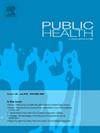The effect of short-term exposure to air pollution on the admission of ischemic stroke and its interaction with meteorological factors
IF 3.9
3区 医学
Q1 PUBLIC, ENVIRONMENTAL & OCCUPATIONAL HEALTH
引用次数: 0
Abstract
Objectives
The aim of this study was to investigate the associations, potential effects, and interactions between short-term exposure to air pollution and the risk of ischemic stroke (IS).
Study design
An ecological study.
Methods
Daily data on IS incidents, air pollution, and meteorological conditions were collected from 2017 to 2021 in Gannan. A time-stratified case-crossover design, combined with a distributional lag nonlinear model, was employed to analyze the relationship between air pollution exposure and the admission of IS. Additionally, the interaction between air pollutants and meteorological factors was examined using bivariate response surface modeling. The study also conducted stratified analyses based on gender, age, marital status, medical insurance purchase status, and season of admission.
Results
In the single lag day structure, extremely low levels of PM2.5 (RR = 1.11, 95 % CI: 1.03–1.20) and PM10 (RR = 1.10, 95 % CI: 1.02–1.20) peaked on lag 3. Conversely, extremely high levels of NO2 (RR = 1.05, 95 % CI: 1.01–1.10), CO (RR = 1.19, 95 % CI: 1.03–1.37), and extremely low levels of O3 (RR = 1.09, 95 % CI: 1.01–1.19) exhibited a greater relative risk on lag 4. In the cumulative lag-day structure, extremely high levels of NO2 exhibited the most significant hazard effect at lag 05 (RR = 1.27, 95 % CI: 1.01–1.52), while extremely low levels of CO at lag 02 (RR = 1.15, 95 % CI: 1.05–1.24) and extremely low levels of O3 at lag 01 (RR = 1.20, 95 % CI: 1.04–1.40) also demonstrated notable associations. In the subgroup stratum, the association between air pollution and IS was found to be more significant in patients who were male, aged <65 years, married, had medical insurance, and were admitted during the cold season. The lowest number of IS hospitalisations occurred under low relative humidity conditions alongside increasing concentrations of CO.
Conclusions
Short-term exposure to air pollution was positively associated with an increased risk of IS. This association was influenced by factors such as being male, aged <65 years, married, having medical insurance, and admissions during the cold season. Additionally, an interaction was observed between air pollutants and meteorological factors. These findings carry significant public health implications for the prevention of IS.

短期空气污染暴露对缺血性脑卒中入院的影响及其与气象因素的相互作用。
目的:本研究的目的是调查短期暴露于空气污染与缺血性中风(IS)风险之间的关联、潜在影响和相互作用。研究设计:生态学研究。方法:收集2017 - 2021年甘南州IS事件、空气污染和气象条件的日常数据。采用时间分层病例交叉设计,结合分布滞后非线性模型,分析空气污染暴露与IS入院之间的关系。此外,利用双变量响应面模型分析了大气污染物与气象因子之间的相互作用。该研究还根据性别、年龄、婚姻状况、医疗保险购买状况和入院季节进行了分层分析。结果:在单一滞后日结构中,极低水平的PM2.5 (RR = 1.11, 95% CI: 1.03-1.20)和PM10 (RR = 1.10, 95% CI: 1.02-1.20)在滞后日达到峰值。相反,极高水平的NO2 (RR = 1.05, 95% CI: 1.01-1.10)、CO (RR = 1.19, 95% CI: 1.03-1.37)和极低水平的O3 (RR = 1.09, 95% CI: 1.01-1.19)在滞后4表现出更大的相对风险。在累积滞后日结构中,极高水平的NO2在滞后05时表现出最显著的危害效应(RR = 1.27, 95% CI: 1.01 ~ 1.52),而极低水平的CO在滞后02时(RR = 1.15, 95% CI: 1.05 ~ 1.24)和极低水平的O3在滞后01时(RR = 1.20, 95% CI: 1.04 ~ 1.40)也表现出显著的关联。在亚组层中,空气污染与IS之间的关联在男性、老年患者中更为显著。结论:短期暴露于空气污染与IS风险增加呈正相关。这种关联受到男性、年龄等因素的影响
本文章由计算机程序翻译,如有差异,请以英文原文为准。
求助全文
约1分钟内获得全文
求助全文
来源期刊

Public Health
医学-公共卫生、环境卫生与职业卫生
CiteScore
7.60
自引率
0.00%
发文量
280
审稿时长
37 days
期刊介绍:
Public Health is an international, multidisciplinary peer-reviewed journal. It publishes original papers, reviews and short reports on all aspects of the science, philosophy, and practice of public health.
 求助内容:
求助内容: 应助结果提醒方式:
应助结果提醒方式:


